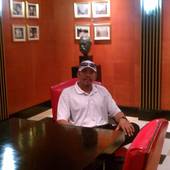EIFS in a nutshell
- EIFS are built-up exterior finish ?systems? used in residential and commercial construction. There are two types of EIFS: barrier and drainable. Barrier EIFS is no longer used in residential wood-framed construction. In the late 1990s many cities outlawed barrier EIFS due to the large amount of moisture related damage. Barrier systems have been replaced with drainable systems for the most part.
- EIFS can be applied to any exterior wall type, whether it's sheathed with plywood, OSB, gypsum board or constructed with concrete or masonry.
- EIFS improve energy efficiency, adds curb appeal to an otherwise ordinary facade.
- EIFS offer designers a variety of textures, colors and architectural shapes.

So what's Barrier EIFS?

- A foam insulation board attached to the wall with an adhesive or with mechanical fasteners. I only apply EIFS to cement substrates not on wood like EIMA would have us do.
- A polymer base coat reinforced with a glass fiber mesh.
- A polymer finish coat available in limitless colors and in many textures.
What's drainable EIFS?
- EIFS drainage systems are comparable to barrier EIFS. The main difference between the two is the introduction of moisture barriers and drainage paths.
- Drainable paths are basically a mesh material attached to the tar paper or Tyvek/building wrap.
- Flashing is usually provided to drain any incidental moisture intrusion behind the EIFS.
Do I have EIFS or stucco?
- EIFS and traditional stucco look very similar and telling the difference can be difficult to the naked eye.
- The best way to determine if you have EIFS is to get up close and personal. You literally have to apply pressure to the wall with your hand. If you can feel or see the lamina going in when you apply pressure then you have EIFS, if not, you probably have traditional stucco. Another method is to lightly knock on the wall. the sound should be a hollow one.
- Stucco, used for hundreds of years, is comprised of cement, sand, water, and lime. For that reason, when knocked, it will sound solid and heavy.
- Since EIFS are composed of thin polymer coating which is about 3/8 of an inch thick and is applied over foam insulation board, they sound light and hollow when knocked.
What are the problems associated with barrier EIFS?
- EIFS are barriers and don't let water in. Every single case where water has been found behind the system entered by way of joints between windows, doors, corners, and openings for plumbing or electrical systems, flashing and pretty much all the terminations.
- When moisture enters, there is no path for the moisture to exit. It's like a styrofoam cup with a lid on it. The moisture becomes trapped and causes wood to deteriorate and rot over time.
- Problems with barrier EIFS have been reported all across the country.
Who's fault is it?
That's the million dollar question.
| Manufacturers often cite. . . | Contractors often cite. . . |
|
|
What has the industry done about it?
- Most EIFS manufacturers still blame the applicators.
- Manufacturers supply drainable systems.
- EIMA, NAHB, AWCI, EDI and the rest of the alphabet outfits have developed training programs. (blind leading the blind)

Comments(2)